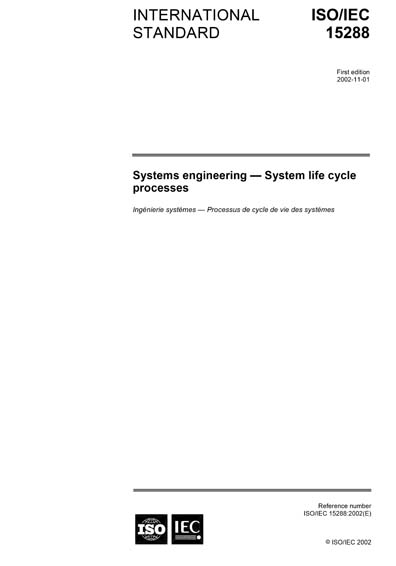Historical
ISO/IEC 15288:2002
Systems engineering - System life cycle processes
This International Standard establishes a common framework for describing the life cycle of systems created by humans. It defines a set of processes and associated terminology. These processes can be applied at any level in the hierarchy of a system's structure. Selected sets of these processes can be applied throughout the life cycle for managing and performing the stages of a system's life cycle. This is accomplished through the involvement of all interested parties with the ultimate goal of achieving customer satisfaction.
This International Standard also provides processes that support the definition, control and improvement of the life cycle processes used within an organization or a project. Organizations and projects can use these life cycle processes when acquiring and supplying systems.
This International Standard concerns those systems that are man-made and may be configured with one or more of the following: hardware, software, humans, processes (e.g. review process), procedures (e.g. operator instructions), facilities and naturally occurring entities (e.g. water, organisms, minerals).
Field Of Application
This International Standard applies to the full life cycle of systems, including conception, development, production, utilization, support and retirement of systems, and to the acquisition and supply of systems, whether performed internally or externally to an organization. The life cycle processes of this International Standard can be applied concurrently, iteratively and recursively to a system and its elements.
There is a wide variety of systems in terms of their purpose, domain of application, complexity, size, novelty, adaptability, quantities, locations, life spans and evolution. This International Standard describes the processes that comprise the life cycle of any man-made system. It therefore applies to one-of-a-kind systems, mass-produced systems and customized, adaptable systems.
This International Standard applies to organizations in their role as both acquirers and suppliers. It can be used by a single party in a self-imposed mode or in a multi-party situation. Parties can be from the same organization or from different organizations and the situation can range from an informal agreement to a formal contract.
The processes in this International Standard can be used as a basis for establishing business environments, e.g. methods, techniques, tools and trained personnel. It provides a process reference model characterized in terms of the process purpose and the process outcomes that result from their successful implementation. This International Standard can therefore be used as a reference model to support process assessment as specified in ISO/IEC TR 15504-2.
Limitations
This International Standard does not detail the life cycle processes in terms of methods or procedures required to meet the requirements and outcomes of a process.
This International Standard does not detail documentation in terms of name, format, explicit content and recording media.
This International Standard is not intended to be in conflict with any organization's policies, procedures, and standards or with any national laws and regulations. Any such conflict should be resolved before using this International Standard.
Content Provider
International Organization for Standardization [iso]






